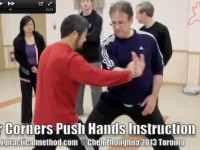– Once you learn the choreography, your ability is highly dependent on the rhythm.
– Whenever you are doing a true rotation, there is no backward moves. It is like you are pushing a wheel barrel 45 degree up the hill. Every time you stop, you have to put a wedge to jam the wheel. So you can keep going. Whenever you let go or go back, you will roll down the hill. Example is Cloud Hands. You advance, jam and then advance and jam. We use the elbow to jam so the hand is free to do the next move.
My understanding is the jam is the anchor, every move there is an anchoring point. Elbow and kua are used to anchor. In this way you can keep coiling and never lose the power. It is like you have an anti-reversing lock. https://www.shiyongquanfa.cn/archives/118607
Read more


